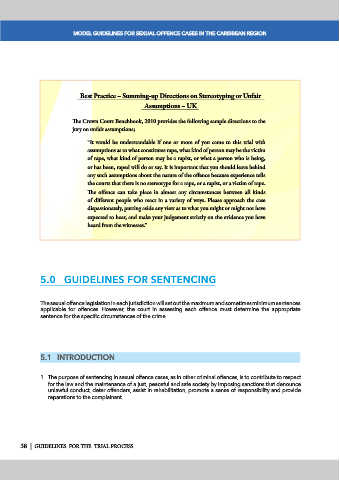Page 637 - Magistrates Conference 2019
P. 637
MODEL GUIDELINES FOR SEXUAL OFFENCE CASES IN THE CARIBBEAN REGION
Best Practice – Summing-up Directions on Stereotyping or Unfair
Assumptions – UK
The Crown Court Benchbook, 2010 provides the following sample directions to the
jury on unfair assumptions;
“It would be understandable if one or more of you came to this trial with
assumptions as to what constitutes rape, what kind of person may be the victim
of rape, what kind of person may be a rapist, or what a person who is being,
or has been, raped will do or say. It is important that you should leave behind
any such assumptions about the nature of the offence because experience tells
the courts that there is no stereotype for a rape, or a rapist, or a victim of rape.
The offence can take place in almost any circumstances between all kinds
of different people who react in a variety of ways. Please approach the case
dispassionately, putting aside any view as to what you might or might not have
expected to hear, and make your judgement strictly on the evidence you have
heard from the witnesses.”
5.0 GUIDELINES FOR SENTENCING
The sexual offence legislation in each jurisdiction will set out the maximum and sometimes minimum sentences
applicable for offences. However, the court in assessing each offence must determine the appropriate
sentence for the specific circumstances of the crime.
5.1 INTRODUCTION
1. The purpose of sentencing in sexual offence cases, as in other criminal offences, is to contribute to respect
for the law and the maintenance of a just, peaceful and safe society by imposing sanctions that denounce
unlawful conduct, deter offenders, assist in rehabilitation, promote a sense of responsibility and provide
reparations to the complainant.
38 | GUIDELINES FOR THE TRIAL PROCESS

